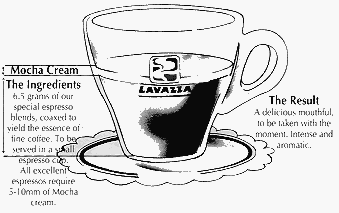How to make a good coffee latte and foam
Have you ever had such a cappuccino? It looks like a cup of art and tastes silky? I hope you have, because that's what a cappuccino is all about. If you've ever had a cappuccino like this, I think you'll probably agree with me: it's hard to drink any more bubbly, fluffy cappuccinos. So what makes a "real" cappuccino so delicious? Of course it's the skill of a barista. The skill of milking is not so easy. But with some good advice and some training, you will immediately impress your cappuccino enthusiasts. Coffee lovers always take it as an honor to make their own favorite fancy coffee, and so do I. I like individual coffee and fancy coffee with various patterns.
However, a very important step in fancy coffee making is to produce high-quality milk foam. There are two more ways to foam, that is, manual foam and coffee maker. Today, what I share with my friends are the skills of Italian coffee maker and some little guidelines for making foam.
I hope it will be helpful to all my friends.

The skill of making milk foam with Italian coffee machine
1. Do not put the steam pipe into the milk, because there may be some condensed water vapor in the steam pipe, so you need to put it for a while before preparing to foam to drain the excess water from the pipe.
2. Beginners can insert the thermometer into the container, then insert the steam pipe obliquely into the milk, and then turn on the steam switch.
3. Slowly adjust the position of the steam nozzle to a little bit from the surface of the milk, but never above the liquid level, or the milk will be spilled everywhere. When the position is correct, a steady "hiss" sound will be heard, and the milk level will begin to rotate. If the steam pipe is scaled in the wrong position, it will be very loud or almost silent, and the milk surface may be bubbling continuously.
4. After the milk foam has been continuously dense, bury the steam pipe a little deeper and let the steam continue to heat the milk. The steam pipe had better be buried at an angle just enough to make the milk rotate.
5. When the temperature reaches 60 ~ 65 degrees, when the hands feel slightly hot, you can turn off the steam switch.
6. Wipe the milk attached to the steam pipe with a wet dishcloth, and at the same time release the steam to spray the remaining milk out with the steam, so as not to block the steam pipe after the milk dries.
At this point, the teachers of Wang Sen Coffee training School shared so much at first that it would lead to indigestion. Friends can also try in accordance with the above methods, oh, play a few more times, will certainly be able to play a satisfactory milk foam.
Some suggestions and tips for milking
Espresso Coffee Machine: at present, all espresso machines on the market have steam pipes for foam. Some manufacturers decide to put turbo nozzel on their steam pipes to help their customers. If you have something like this on your coffee machine, please take it off as much as possible, because it won't help us with what we're going to do next.
Flower cup: preferably a stainless steel flower cup with a water outlet. You need the kind of flower cup whose temperature can change with the milk, so you can feel the temperature of the milk at any time without steaming it too hot. Stainless steel happens to have this property. The outlet can help you when you pull flowers.
Milk: the fat content of milk used in latte drinks is basically about 3%. The less fat, the harder the foam. What you want is smooth foam (so forget about fat-free cappuccinos).
About foam: the main thing to keep in mind when making foam is to stop when the temperature reaches the right point. The appropriate temperature refers to 55-65 °C, depending on your taste. Foaming for too long will condense the milk and change its taste (and cappuccino will be too hot). Overheated milk can also make the foam too hard. How different will the foam be? Here are some typical examples:
Blistering: if you are distracted or inattentive when you are milking, it is easy to cause the steam pipe to be above the surface of the milk rather than just below it. The result is milk spatter and larger milk bubbles. Of course you can still get a lot of foam in the flower cup, but it will taste bad.
Too hard: the hard foam looks stiff, and it doesn't mix with the coffee when you pour it into the coffee, but accumulates on top of your coffee like fluffy beaten cream. If you play a little longer, it will be layered, 90% of which is flowing milk, and a thick hard foam lid floating on it. When you pour it into the coffee, the milk will flow out of the flower cup first. You must scoop the foam into the coffee cup with a spoon.
Smooth: if you do everything right, when you pour out the foam, the milk looks smooth and creamy, a bit like pouring yogurt. The milk and your espresso will mix perfectly, and the crema will color the surface of the milk to form a typical brown edge of the cappuccino.
Rebeaten milk often makes hard foam. The trick is to make the right quantity and quality of milk foam in the flower cup at the right temperature. To foam well, you need to know how fast your machine heats up the amount of milk you want.
A good piece of advice is not to take less than two cups of cappuccino at a time when you start learning to make milk foam.

About the steam in the coffee machine:
1. After the machine reaches the correct temperature, turn on the steam switch, release the water that always exists in the steam pipe, and then turn off the steam switch.
two。 Put the nozzle below the surface of the milk and turn on the steam. If you turn on the steam when the nozzle is above the liquid level, you will get larger bubbles, and it will take a lot of effort to get rid of these bubbles.
3. Slowly take the nozzle to the surface of the milk. Stop (stop just as it breaks the surface) just as the nozzle is about to come off the surface. Now that the air is sucked into the milk, you will hear a typical hiss. If you accidentally take the nozzle out of the water, the pressurized air will blow on top of the milk instead of into the milk, resulting in large bubbles.
4. At this stage, there is no doubt that you have formed small and medium-sized bubbles on the surface of the milk. Now we will try to get rid of them. There will be a whirlpool where the air blows into the milk. All the bubbles on the surface will be pulled into this whirlpool and disappear. It is important to put the nozzle in the right place to avoid new bubbles.
5. Now you have a texture made of tiny bubbles. Put your empty hand on the flower cup to feel the temperature of the milk. When the foam rises, you lower the steam pipe carefully so that it touches the milk. If you are satisfied with the amount of foam and the milk is not warm enough, you can lower the nozzle into the milk. Now the milk is beginning to swirl. By doing so, the milk can be evenly heated by steam. When your hands feel a little hot, keep the nozzle below the liquid level and turn off the steam.
Start a milk whirlpool and pour in:
There are still bubbles in your foam a lot of times. A good way to get rid of these bubbles is to tap the flower cup on the workbench. Don't knock too many times so as not to cause too much foam. A good way to judge whether the milk is thick enough is to rotate the flower cup so that the milk begins to form a whirlpool. You have to make more cappuccinos to learn what milk should look like.
Some tips to see if the foam is good enough:
You can also tilt the flower cup to see how thick the milk is in the outlet. Look at the following example:
Milk should not be too thick, because if it is too thick, it will not mix well with coffee.
Milk should look like you're pouring yogurt (it may sound like a strange metaphor, but it is)
Pour the milk slowly. If it looks easy to flow, just wait a few seconds. By waiting for the air that has been blown into the milk to rise to the surface, the milk can be layered and the foam floats on it. It's like what happens after the black beer is poured out. In order to get the correct cream properties, you now need to blow the milk out of the whirlpool to mix it. You may get a nice cappuccino by doing this, but it may not be two.
Source: network
Important Notice :
前街咖啡 FrontStreet Coffee has moved to new addredd:
FrontStreet Coffee Address: 315,Donghua East Road,GuangZhou
Tel:020 38364473
- Prev

How thick is the bubble thickness required for cappuccino? To what extent does the milk finally need to be disposed?
1.ESPRESSO (concentrated) 2.LATTE (latte) 3.cappucino (cappuccino) have seen more complete and intuitive color images on the Internet before, but they can't find them. The thickness of cappuccino foam first depends on what kind of cup you use. Generally speaking, it is easy to quantify with a standard Italian coffee cup. Concentrated, cappuccino and latte all have cups of different sizes. A ration of coffee
- Next

Analysis of three Coffee Trends in the World knowledge of instant coffee, Starbucks coffee and boutique coffee
From instant drinking to sitting in a coffee shop to hand brewing, this is the love process between most coffee lovers and coffee. Importantly, this is also a true portrayal of the three waves of coffee. When you drink coffee, you have to know its history. The first wave of coffee arose from instant coffee, represented by Nestl é and Maxwell, which tasted delicious and Didi fragrant, almost the enlightenment of mainland coffee.
Related
- What is the meaning of lactic acid fermentation with coffee bean treatment?
- How to judge the state of foam by sound?
- How does the latte pull out the unicorn pattern? Come to get for a little trick to improve the flower pull!
- Will flower pulling affect the taste of the latte?
- Do you know the history of coffee?
- The difference between honey treatment and sun washing what is raisin honey treatment?
- What kind of milk can a novice use to make coffee foam to keep the foam longer? The correct method and skills of milking tutorial sharing
- Why do washed coffee beans taste sour? Flavor characteristics of washed Coffee
- Introduction to the skill of how to practice the size and height of water injection around the circle of hand-brewed coffee
- How do beginners practice coffee flower drawing from scratch?

